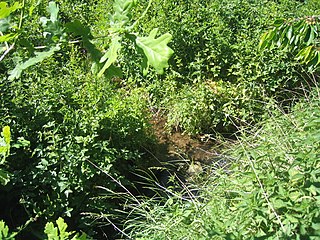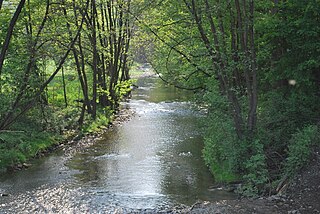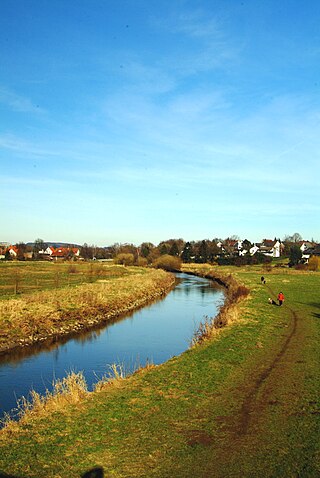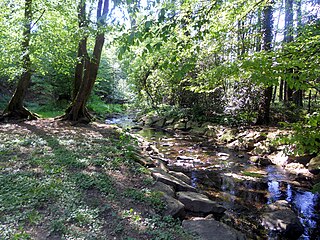
North Rhine-Westphalia or North-Rhine/Westphalia, commonly shortened to NRW, is a state (Land) in Western Germany. With more than 18 million inhabitants, it is the most populous state in Germany. Apart from the city-states, it is also the most densely populated state in Germany. Covering an area of 34,084 km2 (13,160 sq mi), it is the fourth-largest German state by size.

The Sauerland is a rural, hilly area spreading across most of the south-eastern part of North Rhine-Westphalia, in parts heavily forested and, apart from the major valleys, sparsely inhabited.

The Vechte or Vecht, often called Overijsselse Vecht in the Netherlands to avoid confusion with its Utrecht counterpart, is a river in Germany and the Netherlands. Its total length is 182 km (113 mi), of which 107 km (66 mi) is in Germany.

The Inde is a small river in Belgium and in North Rhine-Westphalia, Germany

The Roer or Rur is a major river that flows through portions of Belgium, Germany and the Netherlands. It is a right (eastern) tributary to the Meuse. About 90 percent of the river's course is in Germany.

The Wupper is a right tributary of the Rhine in the state of North Rhine-Westphalia, Germany. Rising near Marienheide in western Sauerland it runs through the mountainous region of the Bergisches Land in Berg County and enters the Rhine at Leverkusen, south of Düsseldorf. Its upper course is called the Wipper. Both names are related to "weave", and refer to the twisting course.

The Düssel is a small right tributary of the river Rhine in North Rhine Westphalia, Germany. Its source is east of Wülfrath. It flows westward through the Neander Valley where the fossils of the first known to be Neanderthal man were found in August 1856. At Düsseldorf it forms a river delta by splitting into four streams, which all join the Rhine after a few kilometres. The Nördliche Düssel flows through the Hofgarten and passes under the Golden Bridge.
The Constitution of North Rhine-Westphalia is the constitutional document that governs the responsibilities and rights of various offices and the Landtag of North Rhine-Westphalia, in Germany.

The Große Aue is an 88-kilometre-long (55 mi), southwestern, left tributary of the River Weser in northern North Rhine-Westphalia and central Lower Saxony in Germany.

The Nordbach is a 1.7 kilometre long, left tributary of the Große Aue in East Westphalian Rödinghausen in the district of Herford in the German state of North Rhine-Westphalia

Röhr is a river of North Rhine-Westphalia, Germany. It is a left tributary of the Ruhr river, itself a tributary of the Rhine. It flows into the Ruhr in Arnsberg-Hüsten.

The Urft is a 46.4-kilometre-long (28.8 mi) right-hand tributary of the Rur in the county of Euskirchen in the German state of North Rhine-Westphalia. It flows through the village of Urft in the municipality of Kall. The Urft rises in the North Eifel region of the Eifel Mountains.

The Armuthsbach is an 18.4-kilometre-long, orographically left-hand tributary of the Ahr in the German states of North Rhine-Westphalia and Rhineland-Palatinate.

Aa is a river of North Rhine-Westphalia, Germany. It is a left tributary of the Werre, which it joins in Herford. It is formed by the confluence of two small streams in Bielefeld-Milse. In its upper part, it is called Johannisbach.

Bever is a river of North Rhine-Westphalia, Germany. It flows into the Weser in Beverungen.

Dhünn is a 40 km (25 mi)-long river located in North Rhine-Westphalia, Germany. Its main source is near Wipperfürth in the Bergisches Land area. It runs in a south-westerly direction, and its mouth into the river Wupper is near Leverkusen, appr. 10 km (6.2 mi) north of Cologne.
Kleine Aa is a river of North Rhine-Westphalia, Germany, a tributary of the Aabach. Thus it is part of the Rhine River Basin.

Lochbach is a river of North Rhine-Westphalia, Germany.

The Saalbach is a stream in North Rhine-Westphalia, Germany. It is 2.5 km long and a tributary of the Gelpe near Remscheid. The Saalbach lies within two conservation areas and its source is protected as a natural monument.

Lollenbach is a stream of North Rhine-Westphalia, Germany. Its source is between Bürenbruch and Letmathe. The stream has a length of 4.03 km (2.50 mi). Near Reingsen, a part of Schwerte, Lollenbach and Reingser Bach merge to form the Elsebach. Lollenbach is used as a supplier of water for a small fish pond.



















